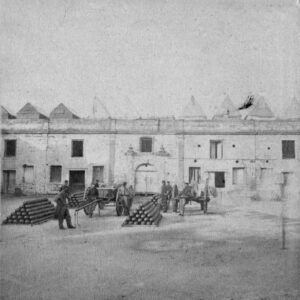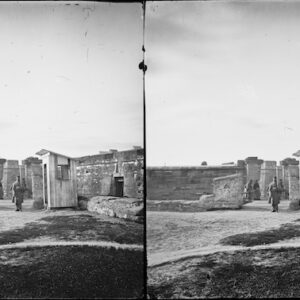Tag: Fort Marion FL
Wikipedia says: The Castillo de San Marcos (Spanish for “St. Mark’s Castle”) [(later Fort Marion)] is the oldest masonry fort in the continental United States; it is located on the western shore of Matanzas Bay in the city of St. Augustine, Florida.
It was designed by the Spanish engineer Ignacio Daza, with construction beginning in 1672, 107 years after the city’s founding by Spanish Admiral and conquistador Pedro Menéndez de Avilés, when Florida was part of the Spanish Empire. The fort’s construction was ordered by Governor Francisco de la Guerra y de la Vega after a raid by the English privateer Robert Searles in 1668 that destroyed much of St. Augustine and damaged the existing wooden fort. Work proceeded under the administration of Guerra’s successor, Manuel de Cendoya in 1671, and the first coquina stones were laid in 1672. The construction of the core of the current fortress was completed in 1695, though it would undergo many alterations and renovations over the centuries.
Though built in part by Black Spanish slaves, the fort later served as one of the first entry points of British-owned African slaves into the Spanish territories, where they were freed by the Spanish. This quickly led to the first free Black settlement in the future United States (Fort Mose, formed just north of St Augustine).
When Britain gained control of Florida in 1763 pursuant to the Treaty of Paris, St. Augustine became the capital of British East Florida, and the fort was renamed Fort St. Mark[ until the Peace of Paris (1783) when Florida was transferred back to Spain and the fort’s original name restored. In 1819, Spain signed the Adams–Onís Treaty which ceded Florida to the United States in 1821; consequently, the fort was designated a United States Army base and renamed Fort Marion, in honor of American Revolutionary War hero Francis Marion. The fort was declared a National Monument in 1924, and after 251 years of continuous military possession, was deactivated in 1933. The 20.48-acre (8.29 ha) site was subsequently turned over to the United States National Park Service. In 1942 the original name, Castillo de San Marcos, was restored by an Act of Congress.
Castillo de San Marcos was attacked several times and twice besieged: first by English colonial forces led by Carolina Colony Governor James Moore in 1702, and then by English Georgia colonial Governor James Oglethorpe in 1740, but was never taken by force. However, possession of the fort has changed six times, all peaceful, among four different governments: Spain, 1695–1763 and 1783–1821, Kingdom of Great Britain, 1763–1783, and the United States of America, 1821–date (during 1861–1865, under control of the Confederate States of America).
Upon receiving the fort from Spain, the Americans changed its name to Fort Marion. It was named to honor General Francis Marion, an American Revolutionary War hero nicknamed “The Swamp Fox.” Structurally, the Americans made few changes to the fort during this time. Many storerooms were converted to prison cells on account of their heavy doors and barred windows. Also, part of the moat was filled in and transformed into an artillery battery as part of the American coastal defense system. The original Spanish seawall was dismantled to ground level and a new seawall constructed immediately adjacent to the seaward side of the original. At this time a hotshot furnace was also built in the filled-in section of the moat behind the newly built water battery. Cannonballs were heated in the furnace to fire at wooden enemy ships.
In October 1837, during the Second Seminole War, Seminole chief Osceola was taken prisoner by the Americans while attending a peace conference near Fort Peyton under a flag of truce. He was imprisoned in Fort Marion along with his followers, including Uchee Billy, King Philip and his son Coacoochee (Wild Cat), and then transported to Fort Moultrie on Sullivan’s Island in Charleston’s harbor. Uchee Billy was captured on September 10, 1837, and he died at the fort on November 29. His skull was kept as a curio by Dr. Frederick Weedon. The doctor also decapitated Osceola after his death in Fort Moultrie and kept the head in preservative.
On November 19, 1837, Coacoochee and nineteen other Seminole, including two women, escaped from Fort Marion. Coacoochee, known for fabricating entertaining stories, later said that only he and his friend Talmus Hadjo had escaped – by squeezing through the eight-inch (203 mm) opening of the embrasure located high in their cell and sliding down a makeshift rope into the dry moat. Hadjo, however, was not on the official list of prisoners. However the Seminole escaped, they made their way to their band’s encampment at the headwaters of the Tomoka River, about forty miles south of St. Augustine. Because of their having been poorly treated, they vowed to continue fighting, and the war was prolonged for four more years. The cell from which Coacoochee escaped was long part of the official lore of the fort.
Confederate States period
In January 1861, Florida seceded from the United States in the opening months of the American Civil War. Union troops had withdrawn from the fort, leaving only one man behind as caretaker. In January 1861, Florida troops marched on the fort. The Union soldier manning the fort refused to surrender it unless he was given a receipt for it from the Confederacy. He was given the receipt and the fort was taken by the Confederacy without a shot. Most of the artillery in the fort was sent to other forts, leaving only five cannons in the water battery to defend the fort.
The Saint Augustine Blues, a militia unit formed in St. Augustine, were enrolled into the Confederate Army at Ft. Marion on August 5, 1861. They were assigned to the recently organized Third Florida Infantry as its Company B. More than a dozen former members of the St. Augustine Blues are buried in a row at the city’s Tolomato Cemetery.
The fort, along with the rest of the city of St. Augustine, was reoccupied by Union troops after acting mayor Cristobal Bravo officially surrendered the city to Union Navy fleet commander Christopher Raymond Perry Rodgers on March 11, 1862. The Confederate forces left the city the previous evening in anticipation of the arrival of the Union fleet under the command of Commodore Dupont.
Second United States period
The fort was taken back by Union forces on March 11, 1862, when the USS Wabash entered the bay, finding the city evacuated by Confederate troops. The city leaders were willing to surrender in order to preserve the town, and the city and the fort were retaken without firing a shot. Throughout the rest of the fort’s operational history, it was used as a military prison.
Showing all 14 resultsSorted by latest













